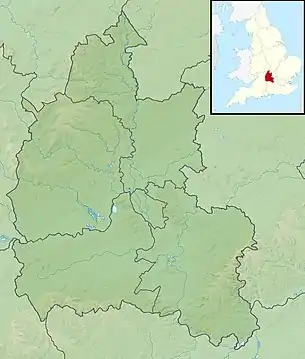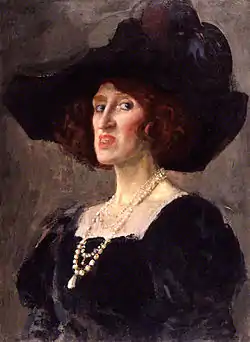Garsington Manor
Garsington Manor, in the village of Garsington, near Oxford, England, is a country house, dating from the 17th century. Its fame derives principally from its owner in the early 20th century, the "legendary Ottoline Morrell, who held court from 1915 to 1924".[1] Members of the Bloomsbury Group, the aristocractic Ottoline, and her wealthy husband Philip, were friends with an array of artists, writers and intellectuals, D. H. Lawrence, T. S. Eliot, E. M. Foster, Bertrand Russell, Virginia Woolf and Siegfried Sassoon being among the visitors to their house. The manor was later owned by Leonard Ingrams and from 1989 to 2010 was the setting for an annual summer opera season, the Garsington Opera, which relocated to Wormsley Park in 2011. Garsington is a Grade II* listed building.
| Garsington Manor | |
|---|---|
 | |
| Type | House |
| Location | Garsington, Oxfordshire |
| Coordinates | 51.7133°N 1.1587°W |
| Built | 17th century, with later alterations |
| Architectural style(s) | Vernacular |
| Governing body | Privately owned |
Listed Building – Grade II* | |
| Official name | Manor House, Garsington |
| Designated | 18 July 1963 |
| Reference no. | 1047686 |
Listed Building – Grade II | |
| Official name | Gatepiers, walls, gates and railings to forecourt of manor house |
| Designated | 25 October 1984 |
| Reference no. | 1181670 |
Listed Building – Grade II | |
| Official name | Pool, summer house and statuary 60M south of manor house |
| Designated | 25 October 1984 |
| Reference no. | 1047689 |
Listed Building – Grade II | |
| Official name | Stables 30M northeast of manor house |
| Designated | 25 October 1984 |
| Reference no. | 1047688 |
Listed Building – Grade II | |
| Official name | Former bakehouse and attached outbuilding 10M northwest of manor house |
| Designated | 25 October 1984 |
| Reference no. | 1047687 |
 Location of Garsington Manor in Oxfordshire | |
History
The manor house was built on land once owned by the son of the poet Geoffrey Chaucer, and at one time had the name "Chaucers".[2] It was constructed in the 1630s by a William Wyckham.[3] Lady Ottoline and her husband, Philip Morrell, bought the manor house in 1913, at which time it was in a state of disrepair, having been in use as a farmhouse. They paid £8,450.[4] Their moving in was delayed until May 1915, due to the continuing occupancy by the former tenants.[5]
Garsington became a haven for the Morrells’ friends, including D. H. Lawrence,[6] Siegfried Sassoon,[7] Edward Sackville-West,[8] Lord David Cecil,[9] Lytton Strachey,[10] Aldous Huxley,[11] Mark Gertler,[12] Bertrand Russell,[13] Virginia Woolf,[6] T. S. Eliot, E. M. Forster and Walter de la Mare.[lower-alpha 1][15] In 1916, they invited conscientious objectors, including Clive Bell and other members of the Bloomsbury Group, to come and work on the home farm for the duration of World War I, as civilian work classified as being of national importance was recognised as an alternative to military service.[16] Aldous Huxley spent some time at Garsington before he wrote Crome Yellow, a book which contains a caricature based on Ottoline for which she never forgave him. His pen portrait of her, written after their first meeting in 1915, summarises the aspects of her character which both attracted and repelled; "[She] is quite an incredible creature - arty beyond the dreams of avarice and a patroness of literature and the modern. She is intelligent, but her affectation is overwhelming".[17] Huxley was not the only one of Ottoline's friends to mock her in print.[18] Her affair with a stonemason Lionel Gomme, known as "Tiger", who worked on the statuary at Garsington, has been cited by some critics as the basis for Lawrence's portrayal of Lady Chatterley's affair with the gamekeeper, Mellor in his novel of 1928.[lower-alpha 2][20][21] Lawrence portrayed her even more directly as Lady Hermione Roddice, in his novel Women in Love. The savagery of the depiction caused a decades-long breach in their friendship, and Philip Morrell threatened to sue Lawrence’s publishers.[22]

In Confidence, a short story by Katherine Mansfield, portrays the "wits of Garsington" some four years before Crome Yellow.[23] Not everyone found the atmosphere congenial; the shy poet Cecil Day-Lewis, taken to Garsington by his tutor Maurice Bowra,[lower-alpha 3] found it "a tremendous ordeal" and sought refuge "slinking gloomily amongst the peacocks" in the Italianate gardens.[25] Lytton Strachey complained that the constant coming and going of guests made work impossible: "I sit quivering among a surging mesh of pugs, peacocks, pianolas, and humans - if humans they can be called - the inhabitants of Circe's cave".[26] David Garnett, a writer, and lover of a number of Ottoline's guests, recorded his impressions of Garsington in his autobiography; "Ottoline's pack of pug dogs trotted everywhere and added to the Beardsley quality, which was one half of her natural taste. The characteristic of every house in which Ottoline lived was its smell and the smell of Garsington was stronger than that of Bedford Square. It reeked of the bowls of potpourri and orris root which stood on every mantelpiece, side table and window-sill and of the desiccated oranges, studded with cloves, which Ottoline loved making".[26]
The Morrells restored the house in the 1920s, working with the architect Philip Tilden, and creating landscaped Italian-style gardens.[27] The parterre has 24 square beds with Irish yews at the corners; the Italian garden has a large ornamental pool enclosed by yew hedges and set with statues. This was designed by Charles Edward Mallows;[28] beyond, is a wild garden, with lime-tree avenues, shrubs, a stream and pond. Financial difficulties forced the Morrells to sell Garsington in 1928. The house was subsequently bought by Sir John Wheeler-Bennett, the historian, who lived there until his death in 1975. It was sold in 1981 to Leonard Ingrams, a banker and brother of Richard.[29] Following Leonard Ingrams' death in 2012, the house was again sold.[30]
Architecture and description
The house is a rectangular structure, of two storeys with attics.[1] The building material is limestone rubble.[31] In his memoirs, True Remembrances-the memoirs of an architect, Philip Tilden recorded the unobtrusive style he sought to achieve at Garsington; "I doubt whether the present-day visitor could spot these alterations, they were made out of odd bits, and the workmanship was carried out by men of the old school".[lower-alpha 4][33]
Garsington is a Grade II* listed building,[31] and its gardens are also grade II* on the Register of Historic Parks and Gardens.[34] An number of other buildings on the estate, and landscaping features in the gardens have Grade II listings including the stables,[35] the bakehouse,[36] the gates at the forecourt to the manor,[37] the pool, a summer house and statuary[38] and an 18th century dovecote.[39]
Notes
- Similarly generous hospitality was dispensed at the Morrell's London home, 44 Bedford Square.[14]
- Gomme died of a brain haemorrhage in the stables at Garsington two years after the start of their affair.[19]
- While guests at Garsington, Bowra read Eliot’s then unpublished manuscript of The Waste Land.[24]
- Despite its title, James Bettley, in his monograph on the architect, notes that Tilden's autobiography contains many falsehoods and is "highly unreliable".[32]
References
- Sherwood & Pevsner 2002, pp. 611-612.
- Manwaring, Kevan (11 September 2018). "Cotswold Ways Walk: A literary ramble around Garsington Manor". Cotswold Life.
- "Garsington Manor". Oxfordshire Gardens Trust. Retrieved 16 January 2021.
- Darroch 2017, p. 174.
- Morrell 1974, p. 31.
- "Journal of Lady Ottoline Morrell". British Library. Retrieved 16 January 2021.
- Prichard, Claudia (6 July 2014). "Unpublished Sassoon poems get first reading". The Independent.
- "Group of visitors at Garsington-Lady Ottoline Morrell Collection". National Portrait Gallery. Retrieved 16 January 2020.
- Gray, Christopher (10 November 2011). "Thoughts on the strange L.P. Hartley". Oxford Mail.
- "Lytton Strachey at Garsington". Smith College. Retrieved 16 January 2021.
- "Aldous Huxley with Lady Ottoline Morrell's pug Soie - Lady Ottoline Morrell Collection". National Portrait Gallery. Retrieved 16 January 2021.
- "Mark Gertler, The Pond, Garsington, 1916". Piano Nobile. Retrieved 16 January 2021.
- "Cavorting by the Pool at Garsington". Metropolitan Museum of Art. Retrieved 16 January 2021.
- Darroch, Sandra (July 2017). "44 Bedford Square" (PDF).
- "Poetry and pretence: the phoney Native American who fooled Bloomsbury set". the Guardian. August 2, 2020.
- Seymour, Miranda (25 July 2014). "Why Garsington Manor was Britain's most scandalous wartime retreat". the Guardian.
- Lattin 2012, p. 32.
- "Journal of Lady Ottoline Morrell, 1917, with accounts of Virginia Woolf and Siegfried Sassoon". The British Library. Retrieved 16 January 2021.
- Caws & Wright 1999, p. 117.
- "The Letters of D. H. Lawrence, edited by Aldous Huxley. London: Heinemann, 1932". Christies. Retrieved 17 January 2021.
- Kennedy, Maev (10 October 2006). "The real Lady Chatterley: society hostess loved and parodied by Bloomsbury group". the Guardian.
- Jones-Davis, Georgia (22 August 1993). "Designing Woman: Ottoline Morrell". Los Angeles Times.
- Alpers 1984, pp. 211-215.
- Mitchell 2010, p. 187.
- Stanford 2007, p. 59.
- "Ottoline Morrell". Spartacus Educational. Retrieved 17 January 2021.
- "Garsington Manor House (Chaucers)". DiCamillo. Retrieved 16 January 2021.
- Strong 1996, pp. 30-31.
- "Garsington Manor launches to the market". Country Life. 21 June 2012.
- "Historic gem Garsington Manor on the market for £6.5M". Homes Luxury. 2 May 2013.
- Historic England. "Manor House, Garsington (Grade II*) (1047686)". National Heritage List for England. Retrieved 15 January 2021.
- Bettley 1987, p. 2.
- Tilden 1954, p. 131.
- Historic England. "Garsington Manor Gardens (Grade II*) (1001095)". National Heritage List for England. Retrieved 16 January 2021.
- Historic England. "Stables 30M northeast of manor house (Grade II) (1047688)". National Heritage List for England. Retrieved 16 January 2021.
- Historic England. "Former bakehouse and attached outbuilding 10M northwest of manor house (Grade II) (1047687)". National Heritage List for England. Retrieved 16 January 2021.
- Historic England. "Gatepiers, walls, gates and railings to forecourt of manor house (Grade II) (1181670)". National Heritage List for England. Retrieved 16 January 2021.
- Historic England. "Pool, summer house and statuary 60M south of manor house (Grade II) (1047689)". National Heritage List for England. Retrieved 16 January 2021.
- Historic England. "Dovecote 75M southeast of manor house (Grade II) (1284896)". National Heritage List for England. Retrieved 16 January 2021.
Sources
- Bettley, James (1987). Lush and Luxurious: the life and work of Philip Tilden 1887–1956. Royal Institute of British Architects. OCLC 466189961.
- Caws, Mary Ann; Wright, Sarah Bird (1999). Bloomsbury and France: Art and Friends. Oxford: Oxford University Press. ISBN 978-0-198-02781-2.
- Darroch, Sandra J. (2017). Garsington Manor: The Legend of Lady Ottoline Morrell. East Barnet, Herts, UK: John Libbey. ISBN 978-0-861-96941-8.
- Lattin, Don (2012). Distilled Spirits: Getting high, then sober, with a famous writer, a forgotten philosopher, and a hopeless drunk. Berkeley, US: University of California Press. ISBN 9780520272323.
- Mansfield, Katherine (1984). Antony Alpers (ed.). The Stories of Katherine Mansfield. Auckland, NZ: Oxford University Press. ISBN 978-0-195-58191-1.
- Mitchell, Leslie (2010). Maurice Bowra: A Life. Oxford: Oxford University Press. ISBN 978-0-199-58933-3.
- Morrell, Ottoline (1963). Robert Gathorne-Hardy (ed.). Ottoline: The Early Memoirs of Lady Ottoline Morrell. London: Faber & Faber. OCLC 1229196175.
- Morrell, Ottoline (1974). Robert Gathorne-Hardy (ed.). Ottoline At Garsington: Memoirs of Lady Ottoline Morrell. London: Faber & Faber. OCLC 185358935.
- Sherwood, Jennifer; Pevsner, Nikolaus (2002). Oxfordshire. The Buildings of England. New Haven, US and London: Yale University Press. ISBN 0-300-09639-9.
- Stanford, Peter (2007). C. Day-Lewis: A Life. London: Bloomsbury. ISBN 978-1-441-12056-4.
- Strong, Roy (1996). Country Life 1897-1997: The English Arcadia. London: Bloomsbury. ISBN 978-0-752-21054-4.
- Tilden, Philip (1954). True Remembrances: The memoirs of an architect. London: Country Life. OCLC 636818090.